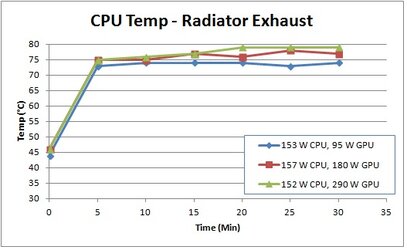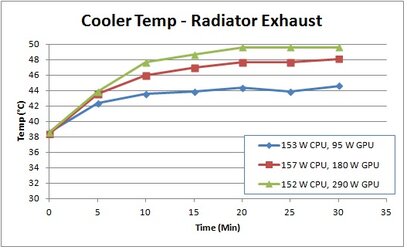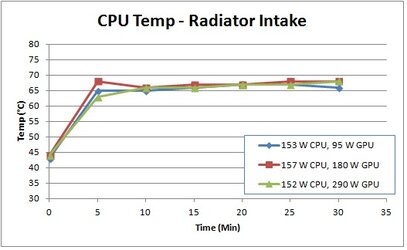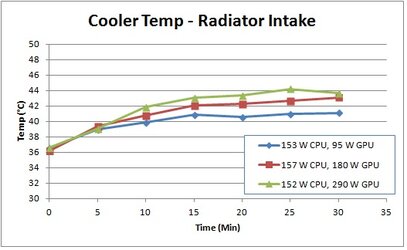- Joined
- Sep 25, 2015
I was pondering a question last night (could have been the flavored brandy...it's brandy season).
The question was: "Is the cooling I am using optimal for my setup".
My rig is in my sig, and my "current state" was to have:
1. Intake fans on front of the case
2. Exhaust fan on back of case
3. Radiator mounted on top of case, with fans taking air from inside the case, blowing through CPU radiator, and exhausting outside the case
4. 2 GTX 970s in SLI, dumping their heat into the case
I read a lot of the forums on the best way to setup a water cooling system. So, I wanted to see the effect of the heat-load of the graphics cards on CPU cooling performance.
I devised a set of experiments to keep the CPU power draw constant, and varied the GPU power. I did a "run" for 30 minutes, taking data at 5 minute intervals. At the start of each run, I brought the coolant back to "nominal temperature" by running the AIO cooling fans at maximum.
I used Seti@Home and Heaven 4.0 to load the system.
Experiment Run 1:
- Seti@Home at 90% CPU, turn off GPU
- CPU power at 153 W, GPU power at 95 W (idle)
Experiment Run 2:
- Seti@Home at 90%, both GPUs running Seti@Home
- CPU power at 155 W, GPU power at 171 W
Experiment Run 3:
- Seti@Home at 60%, Heaven 4.0 running continuously
- CPU Power at 152 W, GPU power at 290 W
---------------------
Setup #1:
- Intake fans on front of case
- Exhaust fan on back of case
- AIO radiator on top of case, fans pulling air from inside the case through radiator as exhaust
Here is a graph of CPU temp (notice it goes up as the GPU power increases):

Here is a graph of the AIO coolant temp (goes WAY up as GPU power increases):

---------------------
Setup #2:
- AIO radiator in front of case, fans pulling outside air into case
- Exhaust fans on top of case
- Exhaust fan on back of case
The results of this shocked me. Here is a graph of CPU temp:

A MASSIVE drop in CPU temp.
Here is the AIO coolant temp:

---------------------
Conclusions:
1. CPU temperature showed an 8 to 10 °C temperature drop with the radiator fans drawing in outside air into the case
2. AIO coolant temperature was 3 to 6 °C cooler with the radiator fans drawing in outside air into the case
3. Drawing air into the case through the radiator is superior
I was concerned about taking this approach due to the AIO blowing heated air into the case. The net effect was that the motherboard temperature increased by about 5 °C, GPU temperatures increased by about 3 °C, and GPU fan speed increased by about 10%.
The question was: "Is the cooling I am using optimal for my setup".
My rig is in my sig, and my "current state" was to have:
1. Intake fans on front of the case
2. Exhaust fan on back of case
3. Radiator mounted on top of case, with fans taking air from inside the case, blowing through CPU radiator, and exhausting outside the case
4. 2 GTX 970s in SLI, dumping their heat into the case
I read a lot of the forums on the best way to setup a water cooling system. So, I wanted to see the effect of the heat-load of the graphics cards on CPU cooling performance.
I devised a set of experiments to keep the CPU power draw constant, and varied the GPU power. I did a "run" for 30 minutes, taking data at 5 minute intervals. At the start of each run, I brought the coolant back to "nominal temperature" by running the AIO cooling fans at maximum.
I used Seti@Home and Heaven 4.0 to load the system.
Experiment Run 1:
- Seti@Home at 90% CPU, turn off GPU
- CPU power at 153 W, GPU power at 95 W (idle)
Experiment Run 2:
- Seti@Home at 90%, both GPUs running Seti@Home
- CPU power at 155 W, GPU power at 171 W
Experiment Run 3:
- Seti@Home at 60%, Heaven 4.0 running continuously
- CPU Power at 152 W, GPU power at 290 W
---------------------
Setup #1:
- Intake fans on front of case
- Exhaust fan on back of case
- AIO radiator on top of case, fans pulling air from inside the case through radiator as exhaust
Here is a graph of CPU temp (notice it goes up as the GPU power increases):

Here is a graph of the AIO coolant temp (goes WAY up as GPU power increases):

---------------------
Setup #2:
- AIO radiator in front of case, fans pulling outside air into case
- Exhaust fans on top of case
- Exhaust fan on back of case
The results of this shocked me. Here is a graph of CPU temp:

A MASSIVE drop in CPU temp.
Here is the AIO coolant temp:

---------------------
Conclusions:
1. CPU temperature showed an 8 to 10 °C temperature drop with the radiator fans drawing in outside air into the case
2. AIO coolant temperature was 3 to 6 °C cooler with the radiator fans drawing in outside air into the case
3. Drawing air into the case through the radiator is superior
I was concerned about taking this approach due to the AIO blowing heated air into the case. The net effect was that the motherboard temperature increased by about 5 °C, GPU temperatures increased by about 3 °C, and GPU fan speed increased by about 10%.
